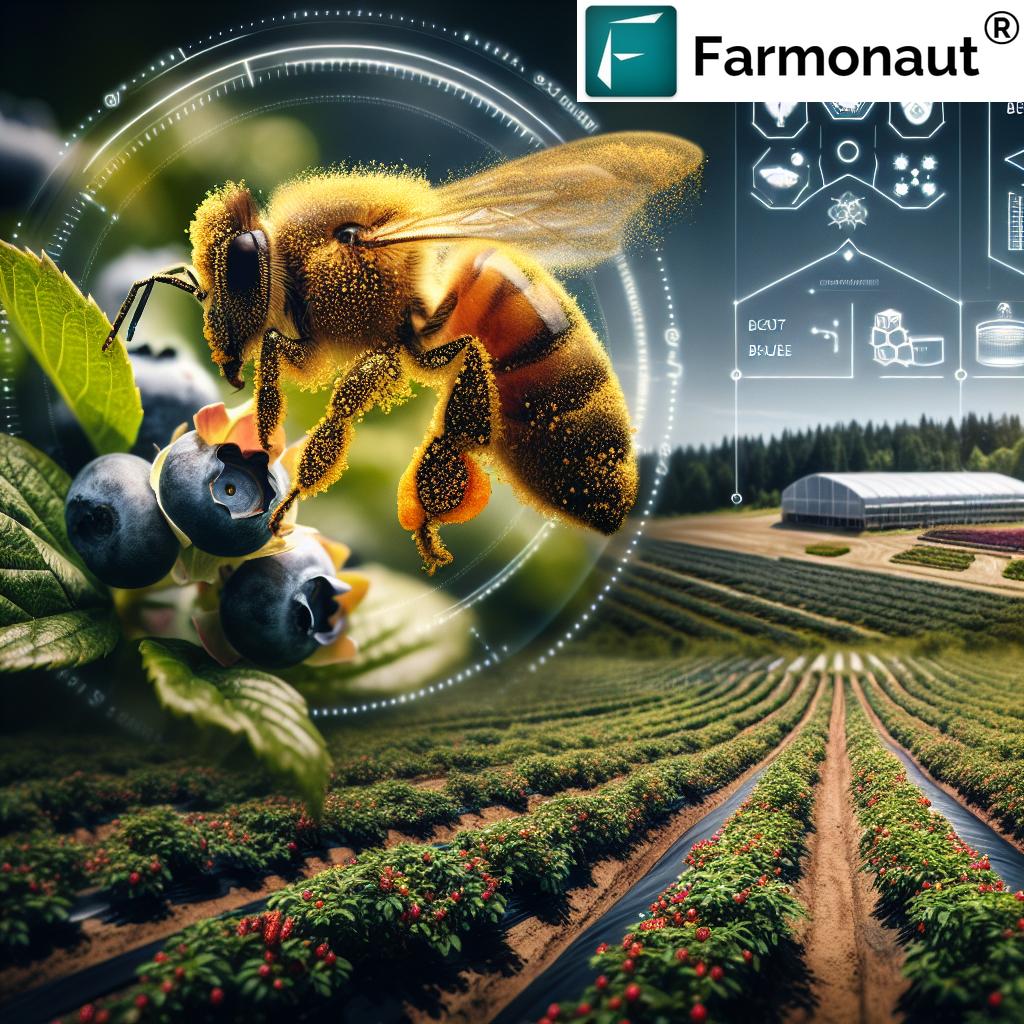Ontario’s Greenhouse Sector: Balancing $2 Billion Growth with Regulatory Challenges in 2024
“Ontario’s greenhouse vegetable sector has grown to nearly $2 billion in value, despite facing regulatory challenges.”
As we delve into the intricate landscape of Ontario’s greenhouse sector in 2024, we find ourselves at a critical juncture where remarkable growth meets significant regulatory hurdles. The greenhouse vegetable production in Ontario has burgeoned into a powerhouse, approaching a staggering $2 billion in farmgate value. This impressive figure not only underscores the sector’s economic importance but also highlights its pivotal role in Canadian food security and agricultural innovation.
However, this growth story is not without its challenges. The industry faces a complex web of regulatory pressures, most notably the federal carbon tax and municipal development charges, which threaten to impede further investment and expansion. These challenges are reshaping the competitive landscape, potentially shifting production southward to Washington state and other U.S. markets.
In this comprehensive analysis, we will explore the multifaceted issues facing Ontario’s greenhouse growers, particularly those cultivating tomatoes, peppers, and cucumbers. We’ll examine the impact of agricultural policies on crop protection, technology adoption, and overall sector growth. Moreover, we’ll discuss the crucial role of advocacy in addressing these challenges and promoting sustainable agriculture practices.
Join us as we navigate through the intricacies of Ontario agriculture sector growth, uncover the effects of agricultural regulatory challenges, and explore innovative solutions that could shape the future of greenhouse vegetable production in Canada.

The Booming Greenhouse Vegetable Sector in Ontario
Ontario’s greenhouse sector has experienced remarkable growth, emerging as a cornerstone of Canadian agriculture. Let’s break down the key factors contributing to this success:
- Economic Impact: The sector’s value approaching $2 billion demonstrates its significant contribution to Ontario’s economy.
- Crop Diversity: Greenhouse tomato cultivation, pepper production, and cucumber farming form the backbone of this thriving industry.
- Technology Adoption: Advanced greenhouse technologies have dramatically increased per-acre yields and improved crop quality.
- Year-round Production: Controlled environments allow for continuous cultivation, ensuring a steady supply of fresh produce.
- Export Potential: Ontario’s greenhouse vegetables have gained popularity in international markets, boosting export revenues.
This growth has positioned Ontario as a leader in North American greenhouse vegetable production, contributing significantly to Canadian food security and economic prosperity. However, with great success comes great challenges, and the sector now faces regulatory hurdles that threaten its continued expansion.
Regulatory Challenges: A Threat to Growth
Despite its impressive growth, Ontario’s greenhouse sector is grappling with several regulatory challenges that could potentially stifle further development:
- Federal Carbon Tax: The implementation of the carbon tax has significantly increased operational costs for greenhouse growers.
- Municipal Development Charges: These charges are making expansion and new facility construction prohibitively expensive.
- Water and Wastewater Regulations: Stricter environmental policies are impacting water usage and treatment practices.
- Minimum Wage Increases: Rising labor costs are squeezing profit margins for growers.
- Packaging Regulations: New rules on packaging materials are adding complexity and cost to the production process.
These regulatory challenges are not just bureaucratic inconveniences; they have real-world implications for the industry’s competitiveness and long-term viability.
The Carbon Tax Conundrum
The federal carbon tax stands out as one of the most significant challenges facing Ontario’s greenhouse sector. Here’s how it’s impacting growers:
- Increased Energy Costs: Greenhouses require substantial energy for heating and lighting, making them particularly vulnerable to carbon pricing.
- Competitive Disadvantage: The tax puts Canadian growers at a disadvantage compared to international competitors not subject to similar carbon pricing.
- Investment Hesitation: The added cost and uncertainty are causing some growers to pause expansion plans or consider relocating operations.
- Technology Adoption Challenges: While the tax aims to encourage cleaner technologies, the increased costs can paradoxically make it harder for growers to invest in energy-efficient upgrades.
The carbon tax impact on farming is a complex issue that requires careful consideration and potentially, policy adjustments to ensure the continued viability of the greenhouse sector.
Municipal Development Charges: A Barrier to Expansion
Municipal development charges are another significant hurdle for greenhouse operators looking to expand their operations. These charges are levied by municipalities to cover the cost of infrastructure needed to support new developments. For greenhouse growers, these charges can be substantial:
- High Costs: Development charges can add millions of dollars to the cost of building new greenhouse facilities.
- Disproportionate Impact: The charges often don’t account for the relatively low infrastructure demands of greenhouse operations compared to other types of development.
- Expansion Deterrent: The high costs associated with these charges are causing some growers to reconsider expansion plans within Ontario.
- Competitive Implications: Areas with lower or no development charges become more attractive for new greenhouse investments, potentially shifting production to other regions.
These charges represent a significant barrier to growth and innovation in the sector, potentially limiting Ontario’s ability to maintain its leadership position in greenhouse vegetable production.

The Shift Southward: Competition from U.S. Markets
“Canadian greenhouse tomato, pepper, and cucumber production is at risk of shifting to the US due to federal carbon tax impacts.”
The regulatory challenges facing Ontario’s greenhouse sector are not occurring in isolation. They’re taking place against a backdrop of intense competition, particularly from neighboring U.S. markets. This competition is leading to a potential shift in production southward, with significant implications for Canadian agriculture:
- Lower Operating Costs: Many U.S. states, particularly Washington state, offer lower energy costs and fewer regulatory burdens.
- Favorable Climate: Some U.S. regions provide natural advantages for greenhouse production, reducing heating and lighting costs.
- Market Access: Proximity to large U.S. consumer markets can reduce transportation costs and improve freshness for U.S.-based operations.
- Regulatory Environment: Less stringent environmental regulations in some U.S. states can lead to lower compliance costs.
This potential shift poses a significant threat to Canadian food security and the economic benefits derived from a strong domestic greenhouse sector. It underscores the need for balanced regulations that support both environmental goals and industry competitiveness.
The Role of Technology in Overcoming Challenges
In the face of these regulatory and competitive challenges, technology emerges as a crucial ally for Ontario’s greenhouse sector. Agricultural technology innovation offers promising solutions to help growers optimize operations, reduce costs, and improve sustainability:
- Energy Efficiency: Advanced climate control systems and LED lighting can significantly reduce energy consumption.
- Water Management: Precision irrigation systems and water recycling technologies help conserve this vital resource.
- Automation: Robotic systems for planting, harvesting, and packaging can help offset rising labor costs.
- Data Analytics: AI-driven analytics can optimize crop management, predicting issues before they arise.
- Renewable Energy: Integration of solar and geothermal systems can reduce reliance on carbon-intensive energy sources.
Companies like Farmonaut are at the forefront of this technological revolution, offering innovative solutions that can help growers navigate the complex regulatory landscape while improving efficiency and sustainability.

Sustainable Agriculture Practices: A Path Forward
As regulatory pressures mount, the adoption of sustainable agriculture practices becomes not just an environmental imperative but an economic necessity for Ontario’s greenhouse sector. Here’s how sustainable practices are shaping the industry:
- Resource Efficiency: Implementing closed-loop systems for water and nutrient recycling reduces waste and environmental impact.
- Integrated Pest Management: Biological control methods minimize the need for chemical pesticides, aligning with consumer preferences for organic produce.
- Carbon Footprint Reduction: Utilizing renewable energy sources and optimizing energy use helps mitigate the impact of carbon taxes.
- Biodiversity Support: Some greenhouse operations are incorporating pollinator-friendly practices, contributing to local ecosystem health.
- Waste Reduction: Innovations in packaging and distribution are helping to minimize plastic waste and food loss.
These sustainable practices not only help growers navigate regulatory challenges but also position them favorably in a market increasingly concerned with environmental stewardship.
The Importance of Advocacy in Shaping Agricultural Policy
In the face of complex regulatory challenges, advocacy plays a crucial role in shaping agricultural policies that balance environmental concerns with the needs of the greenhouse sector. Effective advocacy can:
- Inform Policymakers: Educate government officials about the unique aspects of greenhouse production and its importance to food security.
- Propose Solutions: Offer viable alternatives to blanket regulations that may disproportionately impact the greenhouse sector.
- Build Coalitions: Unite growers, technology providers, and other stakeholders to present a unified voice on key issues.
- Highlight Innovation: Showcase how the sector is adopting sustainable practices and technologies to address environmental concerns.
- Negotiate Compromises: Work towards policy solutions that achieve environmental goals while maintaining sector competitiveness.
As the 2024 federal election approaches, advocacy efforts are ramping up to ensure that the concerns of the greenhouse sector are heard and addressed in future policy decisions.
Explore Farmonaut’s API Solutions
Canadian Food Security: The Stakes at Play
The challenges facing Ontario’s greenhouse sector have far-reaching implications for Canadian food security. Here’s why maintaining a strong domestic greenhouse industry is crucial:
- Year-round Production: Greenhouses provide fresh produce throughout the year, reducing reliance on imports during winter months.
- Supply Chain Resilience: Domestic production helps insulate Canada from international supply chain disruptions.
- Quality Control: Canadian-grown produce meets high safety and quality standards, ensuring consumer confidence.
- Economic Contribution: The sector provides significant employment and economic activity in rural and urban areas.
- Innovation Hub: A thriving greenhouse sector drives agricultural innovation, benefiting the broader farming community.
Balancing regulatory objectives with the need to maintain a strong domestic greenhouse industry is crucial for ensuring long-term food security and agricultural sustainability in Canada.
Preparing for the Future: Industry Adaptation and Innovation
As Ontario’s greenhouse sector navigates these challenges, adaptation and innovation will be key to its continued success. Here are some strategies the industry is employing:
- Diversification: Exploring new crop varieties and value-added products to expand market opportunities.
- Vertical Integration: Some growers are taking control of more of the supply chain to improve efficiency and profitability.
- Collaborative Research: Partnerships with universities and technology firms are driving innovation in growing techniques and crop varieties.
- Market Expansion: Exploring new export markets to reduce dependence on any single market.
- Workforce Development: Investing in training programs to build a skilled workforce capable of managing high-tech greenhouse operations.
These strategies, combined with ongoing advocacy efforts and technological adoption, will be crucial in ensuring the sector’s resilience and continued growth.
Access Farmonaut’s API Developer Docs
Comparative Analysis: Challenges and Solutions
| Challenge | Impact | Potential Solutions |
|---|---|---|
| Federal Carbon Tax | Increased operational costs, potential 5-10% decrease in profitability | Energy-efficient technologies, renewable energy adoption, carbon offset programs |
| Municipal Development Charges | Hindered expansion, potential 15-20% increase in new facility costs | Negotiation with municipalities, advocating for agriculture-specific charge structures |
| Regulatory Hurdles | Compliance costs, potential 3-5% increase in overall operational expenses | Streamlined compliance tools, industry-wide best practices sharing |
| Competition from U.S. Markets | Market share loss, potential 10-15% shift in production southward | Focus on product differentiation, leveraging “local” branding, efficiency improvements |
| Food Security Concerns | Increased reliance on imports, potential 5-8% decrease in domestic supply | Government support programs, public-private partnerships for innovation |
Conclusion: A Balanced Approach for Sustainable Growth
As we look to the future of Ontario’s greenhouse sector, it’s clear that a balanced approach is necessary to address the regulatory challenges while maintaining the industry’s growth trajectory. The sector’s ability to adapt, innovate, and advocate for supportive policies will be crucial in navigating the complex landscape of 2024 and beyond.
The nearly $2 billion valuation of the greenhouse vegetable sector underscores its importance to Ontario’s economy and Canada’s food security. However, the threats posed by regulatory pressures, particularly the federal carbon tax and municipal development charges, cannot be ignored. These challenges require thoughtful solutions that balance environmental goals with the need for a competitive and thriving agricultural sector.
As we’ve explored, technology will play a pivotal role in overcoming these hurdles. Solutions offered by companies like Farmonaut can help growers optimize their operations, reduce resource usage, and improve overall efficiency. By leveraging these advanced tools, greenhouse operators can mitigate some of the impacts of increased regulatory costs while also advancing sustainable agriculture practices.
The potential shift of production to U.S. markets serves as a stark reminder of the need for competitive policies that keep Canadian growers on a level playing field. Advocacy efforts will be crucial in ensuring that policymakers understand the unique challenges and opportunities presented by the greenhouse sector.
Ultimately, the success of Ontario’s greenhouse sector will depend on a collaborative effort between growers, technology providers, policymakers, and consumers. By working together to address challenges, embrace innovation, and promote sustainable practices, we can ensure that this vital industry continues to thrive, providing fresh, locally-grown produce year-round and contributing significantly to Canada’s food security and economic prosperity.
As we move forward, let’s remain committed to fostering an environment where innovation, sustainability, and economic growth can coexist, ensuring that Ontario’s greenhouse sector remains a shining example of agricultural excellence for years to come.
Download Farmonaut’s Android App


FAQs
- Q: How significant is the greenhouse vegetable sector to Ontario’s economy?
A: The greenhouse vegetable sector in Ontario has grown to nearly $2 billion in value, making it a significant contributor to the province’s agricultural economy. - Q: What are the main crops produced in Ontario’s greenhouses?
A: The main crops produced are tomatoes, peppers, and cucumbers, with ongoing diversification into other vegetables and leafy crops. - Q: How is the federal carbon tax impacting greenhouse growers?
A: The carbon tax is increasing operational costs, particularly for heating and lighting, which are essential for year-round greenhouse production. - Q: What role does technology play in addressing regulatory challenges?
A: Technology, such as energy-efficient systems and data analytics, helps growers optimize operations, reduce resource usage, and improve sustainability, mitigating some impacts of regulatory costs. - Q: How does the potential shift of production to the U.S. affect Canadian food security?
A: A shift in production could reduce Canada’s self-sufficiency in fresh produce, potentially increasing reliance on imports and affecting year-round availability of locally grown vegetables. - Q: What are some sustainable practices being adopted by greenhouse growers?
A: Growers are implementing water recycling systems, integrated pest management, energy-efficient technologies, and exploring renewable energy sources to enhance sustainability. - Q: How can advocacy help address the regulatory challenges facing the sector?
A: Advocacy can inform policymakers about the sector’s unique needs, propose balanced solutions, and help negotiate policies that support both environmental goals and industry competitiveness. - Q: What are municipal development charges, and how do they affect greenhouse expansion?
A: Municipal development charges are fees levied on new construction to cover infrastructure costs. For greenhouses, these charges can significantly increase the cost of expansion, potentially deterring growth. - Q: How is the greenhouse sector preparing for future challenges?
A: The sector is focusing on innovation, diversification, workforce development, and exploring new markets to build resilience against future regulatory and competitive challenges. - Q: What role can consumers play in supporting Ontario’s greenhouse sector?
A: Consumers can support the sector by choosing locally grown greenhouse produce, which helps maintain demand for Canadian products and supports local food security efforts.













